Don't wanna be here? Send us removal request.
Text
Healthcare Chatbots: A Smart Solution for Healthcare Efficiency
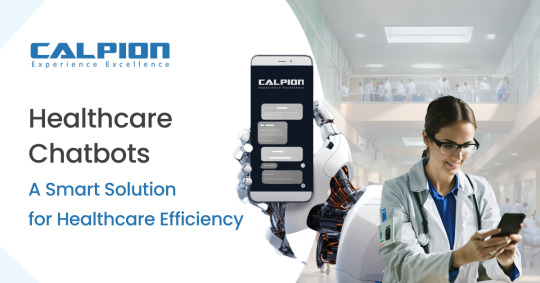
Undoubtedly, technology has changed our lives to an extent where information is available at the click of a mouse or tap on your phone. Google has been the first source of information for all our queries, and with AI integration - ChatGPT, with its latest versions, has adopted a form of search console as well.
When humans fall sick or need urgent assistance regarding their healthcare needs, it is only. Still, it is natural for us to google our symptoms and reach a conclusion; however, with automated bots ready with equipped information and speed of no other, it is a rather reliable solution that healthcare organizations would intend to adopt to their programs.
Chatbots are known for their reliability and quick answers in times of adversity when you need immediate assistance with tasks that do not necessarily involve human intervention. Our latest blog highlights the technological advancements of Chatbots and their role in increasing healthcare efficiency, with patient engagement as a major benefactor.
medical ai chatbots
Patient engagement is at the crux of every healthcare organization due to its increasing impact on patient retention. A healthcare chatbot can improve the patient's experience in various ways, such as making tasks easier for patient appointments, filling prescriptions, as an assistant, etc. Conversational chatbots are all the rage due to hyper-personalization, human-like conversation experience, and speed.
Some of the factors that drive the need for chatbots in healthcare are:
Patients
Providers
Insurance providers
Bots handle 70% of conversations and do not require human assistance, saving around 2.5 billion hours, which can be further utilized for better care and patient support chatbots.
Use Cases of AI Chatbots in Healthcare
Many people realize that adopting automation into their innovation strategy can be a game changer by cost-effectively improving operations throughout the organization, benefiting employees and patients. Embracing new technologies, such as robotic process automation with chatbots in healthcare, is crucial to achieving the interdependent goals of cost reduction and better patient care.
Appointment Scheduler: Patients can chat with chatbots to book appointments with their desired hospitals without waiting on calls or queues like in old times.
Patient Queries: AI chatbots can answer single and multiple queries by patients with a high response rate and accuracy.
Text Reminders/ IVR calls: Patient text reminders and IVR calls remind patients of their due dates of billing and appointments so there are no-shows or loss of collection for the providers.
Diagnostic Chatbots: Preliminary symptoms can be diagnosed using medical picture analysis. Medical AI chatbots can assist patients in better understanding their conditions, making efforts to adhere to prescribed regimens, and following up with healthcare physicians.
Patient Billing Chatbots: With Chatbots as patient engagement software, clinicians may easily contact patients and remind them of their monthly statements through E-statements and text reminders.
A/R calling bots, often known as accounts receivable chatbots, are automated systems that collect outstanding customer payments. Businesses utilize them to automate repetitive tasks like reminder calls, payment schedules, and negotiations.
Remote Monitoring Assistants: Once a patient has completed their medical consultation and is concerned about the side effects, chatbots are utilized to follow up via remote monitoring patient support with a polite conversation. These bots even provide updates on their sessions, lab results, symptom checks, and future progress. These interactions enable patients to quickly resolve their questions and alleviate worry, thus improving their experience.
Advantages of Healthcare Chatbots
Healthcare chatbots that apply the use cases above give providers numerous cost and time savings benefits and a competitive advantage. By 2027, chatbots in healthcare are expected to become the major channel for customer service in one-quarter of enterprises.
24/7 Availability
Data-driven Insights
Resource Allocation
Patient Engagement
Overall cost reduction
Streamline Operations & Increase ROI
Patient Satisfaction
Reducing workforce via automation
How to Successfully Implement a Healthcare Chatbot
The growth of AI and Machine Learning algorithms makes AI chatbot training and implementation easier, resulting in better healthcare outcomes. Statistics indicate that aural and visual features will be merged in the future. This technology encourages organic interactions, boosts user engagement, and makes chatbots in healthcare more accessible. However, enterprises must take specific procedures before installing a chatbot, and Calpion Inc. is your go-to tech bot.
Calpion Inc. provides its complete support with the implementation, management, and deployment of a healthcare chatbot in all its stages via the following steps:
Define your chatbot purpose.
Choosing the right model with the customized model
Regulatory Compliance of HIPAA compliance and SOC-certified.
Map your Patient Journey
Train & improve your Chatbot.
Integrate within existing systems.
Conclusion
Calpion Inc. consistently deploys, maintains, and manages the solutions to ensure flawless functionality while preserving operational efficiency. Healthcare firms may improve patient experience, staff efficiency, resource allocation, and service quality by tailoring chatbots to specific hospital bottlenecks and maximizing their impact.
If you're looking for an AI-powered chatbot or a customized model with unique business requirements, Calpion Inc. is here to solve your challenges. Contact Calpion to learn how our customized AI solutions have helped our healthcare clients improve their productivity, reduce patients waiting time by 1/10th, and enrich their patient experience.
0 notes
Text
Advancing Medicine for the Future with AI-powered Biotech Solutions

The advantages of AI, Machine Learning, and Deep Learning are unparalleled in today's biotechnological marvels. Imagine a realm where automation transcends manual intervention, liberating scientists to explore more experiments and make breakthrough discoveries. Dive into deep learning, where time invested yields a compounding return through increased experimentation and precision in discoveries.
Benefits of Deep Learning Mechanism in Biotechnology
The complexity of large datasets in biotech applications is seamlessly navigated with the prowess of deep learning. AI facilitates the segregation of unstructured data, aligning it with experimental needs and filtering out the extraneous. This saves invaluable time and reduces costs, allowing scientists and staff to focus on critical tasks.
Economizing Through AI Efficiency- Cost-effectiveness takes center stage as AI standardizes and streamlines data integration across diverse processes. Witness a paradigm shift in drug development speed and efficiency, where AI analyzes historical data to forecast trial design errors, resulting in higher success rates and improved patient stratification. The outcome? A substantial reduction in costs and an elevation in overall efficiency.
Advanced Analytics at Your Fingertips- Enter a realm where extensive data analysis takes days or hours, thanks to AI and machine learning. Repetitive tasks, from pattern recognition to flaw detection, are automated, enhancing overall efficiency and expediting decision-making processes.
Scalability Redefined with AI- AI becomes an integral part of the research and development process, significantly curtailing the initial stages of experiments. Complex data sets are collected and processed with predictive reasoning, accelerating processes and scaling businesses to new heights.
Achieve Medical Innovation with Calpion AI-powered Services
Drug Target Identification
Drug Discovery and Material Design
Clinical Trials Solutions
Protein Image Screening
Predictive Modeling
Protein Engineering
Transforming Business Operations Through AI
Embark on a revolutionary path where testable variants are reduced by 95%; operations get streamlined by 90% through AI and a remarkable 80% slashes costs.
In our pursuit of medical innovation, Calpion leverages AI, machine learning, and deep learning for drug target identification, drug discovery, clinical trial solutions, protein image screening, predictive modeling, and protein engineering. Join Calpion in shaping the future of medicine, where each innovation is a step towards personalized, precision healthcare.
Read more: AI-Powered Biotech: Advancing Medicine for the Future
0 notes
Text
Personalize Your Healthcare Approach with Next-Generation AI Solutions
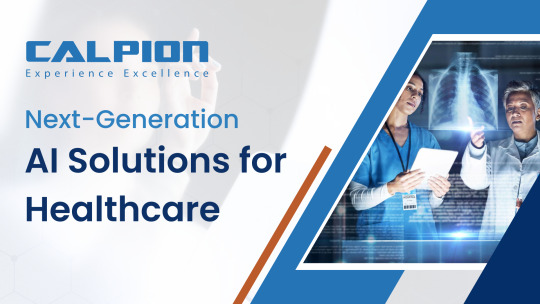
Are you ready to embark on a transformative journey in healthcare innovation? Calpion brings you cutting-edge AI solutions that redefine patient-centric care, setting new standards in healthcare satisfaction. At Calpion, we believe in delivering value-based care through personalized healthcare AI-powered solutions. Our expertise in machine learning is reshaping the healthcare landscape, bringing about the following:
80% Reduction in Time - AI/ML technologies for swift and efficient healthcare processes.
70% Reduction in Manual Efforts - Elevate your operations with enhanced AI, freeing up valuable time for your team.
48 Hrs. Decrease in Turn-Around Time - Experience efficiency with Calpion's innovative AI-powered solutions.
Transform Your Healthcare Business with Calpion's AI-powered Benefits.
Embark on a healthcare revolution with Calpion's AI-driven solutions that redefine patient engagement, streamline processes, and elevate overall healthcare outcomes.
Our custom applications allow providers to build lasting connections through custom-built portals, facilitating seamless patient communication. Transform your approach with data-driven processes, turning documentation into cloud-based insights for optimized decision-making. Foster strong patient relationships through personalized treatment plans, accurate diagnoses, and automated reminders, ensuring improved patient outcomes.
Calpion's key solutions make providers experience operational efficiency by:
-Automating tasks with Robotic Process Automation, allowing your staff to concentrate on high-value responsibilities.
- Overcome obstacles and provide continuous support with 24/7 virtual assistance powered by AI chatbots and deep learning.
Calpion leads the way in AI-driven healthcare, offering personalized medicine, predictive analytics, streamlined operations in Healthcare RCM, remote patient monitoring, medical image analysis, and workflow automation.
Join us in shaping the future of patient-centric care – Read more- Next-Generation AI Solutions for Healthcare
0 notes
Text
AI and Machine Learning: Paving the Path to Building Next-Generation Apps
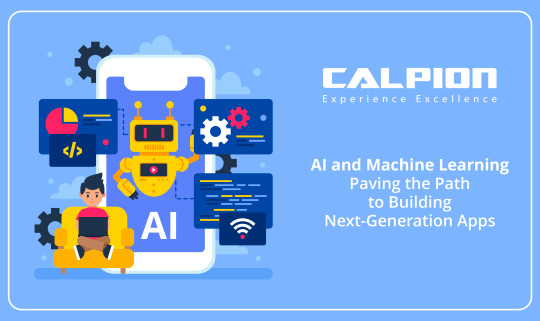
With the recent emergence of Artificial Intelligence advancements and Machine learning's spectrum of utilization in all sectors, AI App development is one of the main sectors to benefit from this toll. The number of smartphone mobile network subscriptions worldwide will exceed 7.7 billion by 2028. With this advancement, app development is necessary for businesses to dive into the bigger market to claim their target audience share.
Our blog on Exploring the Power of AI and Machine Learning in App Development digs deep into the mechanics of exploring the power of AI and Machine learning in App development.
Implementing AI and Machine learning in App Development
Benefits of AI and Machine Learning in App Development
Roadmap for IT Services to Implement AI and ML for App Development
The Future of AI and Machine Learning in App Development
Click here to read our detailed blog on how to develop custom AI App development for your business with Calpion Inc.
#ai#ai app development#custome application development#digital transformation#deeplearning#technology#calpion#software#deeplearningsolutions
1 note
·
View note
Text
Symbiotic Intelligence - The Future of Artificial Intelligence (AI) and Deep Learning (DL)
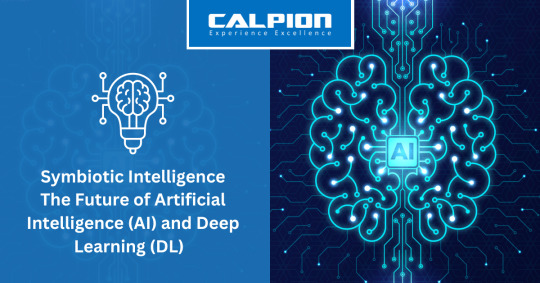
As the world around us continues to evolve, so must the way we think about Artificial Intelligence (AI) and its potential impact on our lives. With the rapid development of AI and deep learning technologies, it is becoming clear that the future of these technologies lies in their ability to work together in symbiosis with humans rather than as a replacement for them. This symbiotic relationship between humans and machines is often called 'symbiotic intelligence.' In symbiotic intelligence, AI and deep learning technologies augment human abilities rather than replace them. This approach has several advantages, both for businesses and individuals.
Read on to learn more about symbiotic intelligence and its potential future implications!
The general definition of Artificial Intelligence (AI) is an automated system created to mimic human learning processes. An AI-based tool receives data, processes it, and determines the outcome. It suggests the best actions possible instead of following repetitive commands or waiting for prompts, as a computer does. It adapts to circumstances as it goes along and doesn't just carry out pre-determined actions when instructed. Instead, it changes and rearranges already-existing options to produce the best results.
Symbiotic intelligence is the amalgamation of Artificial Intelligence (AI) and Human Intelligence (HI) working together to achieve specific goals. It is used by several companies, including Google and Microsoft, to help their customers make better decisions. This article will discuss symbiotic intelligence, its implications, advantages, and the potential future of AI and Deep Learning.
What is Symbiotic Intelligence?
Symbiotic intelligence integrates AI and Human Intelligence (HI) to produce a more efficient system. AI and HI will work together to complete tasks, each providing expertise. Combining two types of intelligence could yield more accurate results and lead to better organizational decision-making.
The concept of symbiotic intelligence has existed for some time, but companies have recently embraced it.
Implications
Symbiotic intelligence has the potential to drastically change the way organizations make decisions and optimize their processes. By combining AI and HI, companies can benefit from the strengths of both types of intelligence. AI can provide the facts and data needed to make decisions, while HI can provide the necessary context and perspective. This combination of the two could result in more accurate and reliable decisions.
In addition, symbiotic intelligence could lead to improved customer service. By utilizing Artificial Intelligence (AI) and HI, companies could develop customer service processes that are more efficient. It could lead to better customer experiences and improved satisfaction.
Advantages of Using Symbiotic Intelligence
There are several advantages of using symbiotic intelligence.
First, it can provide organizations with more accurate and reliable decision-making. By combining AI and HI, organizations are making better decisions to improve their processes.
Second, it can improve customer service.
Third, it can reduce costs. By utilizing AI and HI, organizations can reduce the time and resources needed to make decisions, resulting in cost savings.
Potential Future of AI and Deep Learning
Artificial Intelligence (AI) and Deep Learning have driven the technology industry and revolutionized many aspects of our lives. AI and Deep Learning have countless applications, and the opportunities they create are seemingly endless. As technology advances, AI and DL become more powerful, and their potential future applications become even more exciting.
AI has already enabled many existing technologies and products. It includes digital assistants, facial recognition, and automated customer service applications. AI has also helped more complex tasks such as data analytics and autonomous driving. Deep Learning has allowed even more robust applications such as computer vision and natural language generation.
Though AI and deep Learning are already powerful, their potential future applications are remarkable.
AI and Deep Learning further revolutionize healthcare, biotechnology, cybersecurity, retail, logistics, manufacturing, transportation, and finance. AI and Deep Learning enable personalized medicines, automated diagnostics, and precision treatments in healthcare.
AI and Deep Learning allow vehicle navigation without humans and autonomous driving in transportation.
AI and Deep Learning enable automated trading, virtual banking, and improved customer service in finance.
The robots will become more intelligent and independent and be able to communicate with humans. Autonomous agents like chatbots and virtual assistants may develop and learn to understand natural language.
AI and Deep Learning continue developing, revolutionizing many industries and opening new possibilities. As technology advances, AI and Deep Learning will become even more powerful, and their potential future applications will become even more progressive.
Conclusion: Symbiotic intelligence is the future of Artificial Intelligence (AI), and Deep Learning is the foundation technology upon which symbiotic intelligence works. As we continue to explore and develop these technologies, we will see even more applications and uses, leading to a brighter, more connected world and greater collaboration between man and machine. As such, symbiotic intelligence promises to be an exciting and revolutionary step in the evolution of AI and Deep Learning.
#calpion#ai#deeplearning#deeplearningai#aisoluions#artificialintelligence#machinelearning#deeplearningandmechainlearning#aiforbusiness#ITSolutions#ITServices#ITConsulting#deeplearningalgorithms#machinelearningalgorithms#deeplearningsolutions#customerengagement#digitaltransformation#softwaresolutions#customerexperience#aisolutions#aisoftware
0 notes
Text
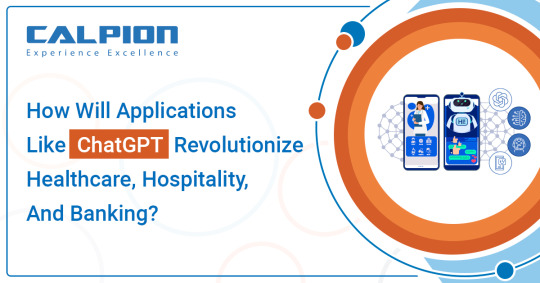
#chatgpt#chatgpthealthcare#chatgpthospitality#chatgptbanking#Aichatgpt#chatbot#aichatbots#ai#artificilintelligency#aihealthcare#aihospitality#aibanking#digitaltransformation#Deeplearning#deeplearningchatgpt#digitalization#blogs#chatgptbot#blogposts#chatgptsoftwaresolutions#chatgptsolutions#calpion#CTO#aichatbot#deeplearningservives#deeplearningsolutions#openai#healthcare#healthcareindustry#hospitality
0 notes
Text
#chatgpt#chatgpthealthcare#chatgpthospitality#chatgptbanking#Aichatgpt#chatbot#aichatbots#ai#artificilintelligency#aihealthcare#aihospitality#aibanking#digitaltransformation#Deeplearning#deeplearningchatgpt#digitalization#blogs#chatgptbot#blogposts#chatgptsoftwaresolutions#chatgptsolutions#calpion#CTO#aichatbot#deeplearningservives#deeplearningsolutions#openai#healthcare#healthcareindustry#hospitality
0 notes
Text
How does ChatGPT revolutionize Healthcare, Hospitality, and Banking?
AI and Deep Learning ChatGPT is a revolutionary app most sought after by industries like Healthcare, Hospitality, and Banking. The aim is to give an immersive customer experience (CX) and have maximum productivity. ChatGPT uses a deep learning technique called transformer architecture to analyze instructions as per customer requirements and articulate answers accordingly. With less or no human intervention, the future will be digital, and users will have the utmost personalized experience that has yet to hear of in recent years.
#chatgpt#chatgpthealthcare#chatgpthospitality#chatgptbanking#Aichatgpt#chatbot#aichatbots#ai#artificilintelligency#aihealthcare#aihospitality#aibanking#digitaltransformation#Deeplearning#deeplearningchatgpt#digitalization#blogs#chatgptbot#blogposts#chatgptsoftwaresolutions#chatgptsolutions#calpion#CTO#aichatbot#deeplearningservives#deeplearningsolutions#openai#healthcare#healthcareindustry#hospitality
0 notes
Text
Exploring the Powerful Impact of AI and Deep Learning Services in 2023 Across Industries
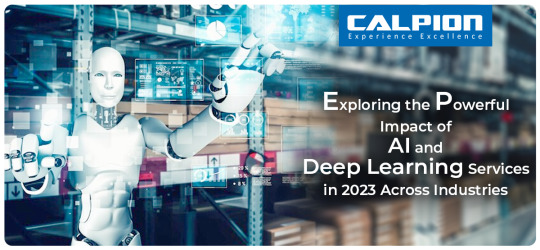
Deep learning is one of the most exciting and rapidly evolving areas of artificial intelligence (AI). It is a type of machine learning that uses algorithms to mimic the brain’s ability to learn and process data. Deep Learning has enabled computers to process and understand large amounts of data with unprecedented accuracy and speed.
What is Deep Learning?
Deep learning is a subfield of machine learning that uses algorithms to learn from large amounts of data. Deep learning algorithms help in various tasks, such as image recognition, natural language processing, and speech recognition.
The key difference between deep learning and traditional machine learning is that deep learning algorithms can learn from data without relying on human intervention. It allows them to make more accurate predictions and decisions than conventional machine learning algorithms.
Benefits of Deep Learning
Deep learning makes more accurate predictions and decisions than traditional algorithms. Deep Learning offers several benefits over standard machine learning algorithms. First, it is more precise than conventional algorithms, as it can learn from data without relying on human intervention.
Second, deep learning algorithms can process large amounts of data quickly and accurately. It makes them well-suited for tasks such as image recognition and natural language processing, which require the processing of large amounts of data.
Finally, deep learning algorithms can learn from data more complexly than traditional algorithms. It allows them to make more complex predictions and decisions than conventional algorithms.
Types of Deep Learning Services
There are several types of deep learning services available today. These include supervised learning, unsupervised learning, and reinforcement learning.
Supervised learning is deep learning that uses labeled data to train the algorithm. In supervised learning, the algorithm is a set of labeled data, which it uses to learn how to make predictions and decisions.
Unsupervised learning is deep learning that uses unlabeled data to train the algorithm. In unsupervised learning, the algorithm is a set of unlabeled data that it uses to learn how to make predictions and decisions.
Reinforcement learning is deep learning that uses rewards and punishments to train the algorithm. It allows learning how to make decisions and predictions efficiently. In reinforcement learning, the algorithm is tips and penalties based on its performance.
Deep Learning Use Cases
Deep learning algorithms help with image recognition, natural language processing, speech recognition, autonomous vehicle navigation, and many other applications across various industries.
Image recognition is a task where deep learning algorithms identify and classify objects in an image. This feature gets used in various applications, such as autonomous vehicle navigation and facial recognition.
Natural language processing is a task where deep learning algorithms process and understand natural language: customer service bots and language translation.
Speech recognition is a task where deep learning algorithms process and understand speech—for example, virtual assistants and automated customer service agents.
Autonomous vehicle navigation is a task where deep learning algorithms navigate and control autonomous vehicles—for example - Self-driving cars and delivery robots.
3D Bioprinting – Ai helps the biotechnology industry with 3D bioprinting. The printer prints living tissues like skin, organs, blood vessels, and bones layer by layer using cells and biomaterials, also known as bioinks, based on a digital blueprint.
Streamlining Production Planning: Deep learning models and techniques train complex algorithms on the production data that is already available in a way that aids in the identification of potential areas of waste and inefficiency.
Deep Learning Services Market Trends:
The deep learning services market is multiplying, with a compound annual growth rate of over 45% from 2016 to 2023. This growth is increasing the need for more accurate and efficient decision-making in many industries, such as healthcare and finance.
The increasing availability of powerful computing resources, such as GPUs and cloud computing, drives the demand for deep learning services. It has allowed organizations to take advantage of deep learning algorithms without investing in expensive hardware.
Finally, the increasing availability of large datasets has allowed organizations to train deep learning algorithms more effectively. It has enabled organizations to make more accurate predictions and decisions.
Challenges Associated with Deep Learning and Solutions to it:
Challenges: Although deep learning services offer several benefits, they also come with many challenges. One of the most significant challenges is the cost of training and deploying deep learning algorithms.
Deep learning requires large amounts of data and powerful computing resources to be effective, which can be expensive. Another challenge is the complexity of deep learning algorithms.
Solutions: To ensure the data is suitable for a deep learning model, you must validate it if you already have it. To create a high-quality dataset, applying best practices for data labeling, cleaning, and debiasing is crucial.
If you are implementing deep learning in your company for the first time, start with smaller models and a cloud service provider. On-premises infrastructure with specialized hardware, such as high-performance GPUs and large data storage devices, can, however, be a more cost-effective choice in the long run if the number and size of your deep learning projects will increase.
Deep Learning as a Service (DaaS)
Many organizations are turning to Deep Learning as a Service (DaaS) to address the challenges associated with deep learning services.
DaaS is a cloud-based service that provides organizations with access to pre-trained deep learning models. It allows organizations to quickly and easily deploy deep learning algorithms without training them from scratch.
In addition, DaaS providers offer several other services, such as model training, model deployment, and model optimization. It allows organizations to customize their deep learning algorithms to meet specific needs.
The Impact of Deep Learning in 2023
The impact of deep learning services will be even more significant in 2023. As organizations continue to invest in deep learning technologies, the accuracy and efficiency of their decision-making will improve significantly.
In addition, the cost of training and deploying deep learning algorithms will decrease significantly. It will make it easier for organizations to take advantage of deep learning algorithms without investing in expensive hardware.
Finally, deep learning algorithms will become even more potent in 2023. It will enable organizations to make more accurate predictions and decisions.
How to Get Started with Deep Learning?
If you’re looking to get started with deep learning services, the first step is finding a service provider. You can rely on Calpion for the best deep-learning solutions.
Then, you can use deep learning services to make predictions and decisions. It will allow you to take advantage of the power of deep learning without having to invest in expensive hardware.
Conclusion
Deep learning services have the potential to revolutionize decision-making in many industries. In 2023, the impact of deep learning services will be more significant as organizations continue to invest in deep learning technologies and the cost of training and deploying Deep Learning algorithms decreases.
If you’re looking to get started with deep learning services, the first step is finding a service provider. Once you’ve found a Deep Learning service provider, you can begin exploring their deep-learning services and use them to make predictions and decisions.
At Calpion, we provide a range of deep learning solutions and services to help you get started with deep learning. For more information, visit Calpion for similar blogs.
#deep learning#ai#artificialintelligenceservices#calpion#machine learning#aiservices#deeplearningsolutions#deeplearningservices#software#technology#digital transformation#robots
0 notes
Text
Basics of Deep Learning – Powered by Calpion
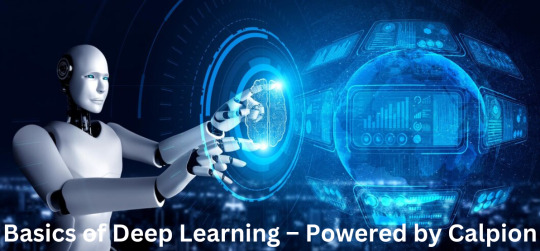
What is Deep Learning?
Deep Learning is a machine learning technique that teaches computers and other devices how to think logically. It is a subset of artificial intelligence. The term "deep learning" refers to delving deeply into several network layers, including a layer. You can extract more complex information as you delve deeper.
Deep Learning enables machines to recognize objects and perform tasks like humans using images, text, or audio files. Deep learning techniques use a variety of intricate programs to mimic human intelligence. With the help of this specific technique, computers recognize motifs and divide them into distinct categories. Deep learning includes pattern recognition, and computers no longer require extensive programming because of machine learning.
You can see examples of how deep learning influences our daily lives in all the self-driving cars you see, the personalized recommendations you encounter, and the voice assistants you use. The key here is data exposure. If properly trained, computers can mimic human performance and deliver accurate results.
Deep learning emphasizes iterative learning techniques that expose computers to enormous data sets. It makes it easier for computers to recognize patterns and adjust to change. Machines learn differences and logic through repeated exposure to data sets, which helps them draw reliable conclusions from data.
Recent advancements in deep learning have improved its dependability for complex functions. It's not surprising that this industry attracts much attention and young professionals.
Why is Deep Learning Important?
Deep learning is becoming increasingly popular. Deep Learning powers automation in the modern world, including face recognition at airports and automated parking assistance. It substantially enhances our daily convenience, and this trend will persist.
Deep learning best uses the expanding volume and accessibility of data. Through iterative learning models, all the data gathered from these sources produce accurate results. The exponential growth of data today explains deep learning's relevance, which necessitates massive data structuring.
Recurrently analyzing enormous datasets removes errors and discrepancies in findings, ultimately leading to a reliable conclusion. Soon, deep learning will continue to impact both the business and personal worlds significantly and generate numerous job opportunities.
How does Deep Learning work?
Deep learning uses iterative techniques to train computers to mimic human intelligence. Deep Learning has the self-learning capability and works with unstructured data. The first level aims to teach basic machine knowledge, and as the levels advance, the ability keeps growing.
Machines learn more information with each new level and combine it with what they already know. A compound input is the last piece of information the system collects during the process. This data is organized in multiple hierarchies and resembles sophisticated logic in data.
Let's see an illustration of deep learning solutions:
Consider how a voice assistant like Alexa or Siri uses deep learning for authentic conversation experiences. When the voice assistant is fed data in the early stages of a neural network, it will attempt to identify voice inundations, intonations, and other things. It will gather vocabulary data for the higher levels and combine it with the results of the lower classes. It will analyze the prompts in the following levels and compile all its findings. The voice assistant will have enough knowledge from the top level of the hierarchy to analyze a dialogue and deliver a corresponding action based on that input.
How do Neurons function in Deep Learning Solutions?
Each input node receives a value after receiving the information (in numerical form). Nodes transfer the activation value based on the transfer function and connection strength, and nodes with higher numbers have more activation value in deep learning ai solutions.
Weights are used in the synapses to design the artificial neural network after activation. The nodes calculate the entire amount and modify it by the transfer function once they have received the activation value. Applying the activation function, which aids the neuron in determining whether a signal passes, is the procedure's following step.
Weights are essential for instructing an Artificial Neural Network (ANN) on how to operate. While an Artificial Neural Network gets trained, activation weights are frequently changed. The Network reaches the output nodes after the activation process. The step that serves as a conduit between the user and the system is this one.
The output node interprets the information so the user can understand it. Cost functions assess the model's performance by comparing the expected and actual output. You can choose from various cost functions to reduce the loss function based on your needs.
Backpropagation is a technique for calculating error function gradients by neural network weights. A back calculation technique produces the desired result by eliminating the incorrect Weights.
On the other hand, forward propagation is a cumulative approach to achieving the desired output. In this approach, the input layers process the data before propagating it throughout the Network. Forward propagation can test the Network to see how it performs after adjusting the weights to the ideal level. Errors get calculated after outcome values with expected results, and the information gets multiplied backward.
What is the difference between Deep Learning and Machine Learning?
Machine Learning: Machine learning is a subset, an application of Artificial Intelligence (AI) that offers the ability of the system to learn and improve from experience without being programmed to that level. Machine Learning uses data to train and find accurate results. Machine learning focuses on developing a computer program that accesses the data and uses it to learn from itself.
Deep Learning: Deep Learning is a subset of Machine Learning where the artificial neural Network and the recurrent neural Network are related. It solves all complex problems with the help of algorithms and its process. The algorithms are created exactly just like machine learning, but it consists of many more levels of algorithms. All these networks of the algorithm are together called the Artificial Neural Network. In much simpler terms, it replicates just like the human brain, as all the neural networks in the brain, which exactly is the concept of deep learning.
Conclusion
In layman’s terms, deep learning teaches computers to do things that would typically require human intelligence, such as facial recognition, analyzing images, voice messages, and natural language processing. Deep Learning can be used for unsupervised learning with unstructured data, where the data is not labeled, and the algorithm has to learn from it.
We've helped our clients save billions by providing personalized AI-enabled deep-learning solutions and services. Please go through our Calpion website to learn more about our Deep Learning Solutions, use cases, and how we can assist you in growing your business. Subscribe to our newsletter for regular AI, Deep Learning & Machine Learning updates
#AI#deeplearning#deeeplearningservices#deeplearningsolutions#deeplearningandmechainlearning#aiforbusiness#Artificialintelligence#Artificialintelligenceservices#Artificialintelligencesolutions#ITSolutions#ITServices#ITConsulting#deeplearningalgorithms#customerengagement#digitaltransformation#softwaresolutions#customerexperience#aisoftware#deeplearningai#machinelearning#machinelearningsolutions#robotics#calpion
1 note
·
View note